Santa says The Links Cup - SA, SA, SA! Links Cup - South Africa shines
Bonus story - Charl shares his stories from the Solheim Cup! Norman Pretorius was injured so, as the SA Captain, he rallied his team by moving from match to match as a "cheerleader" on Sunday. After trailing the Internationals 13-9 after Foursomes and Betterball Play, the SA team found their form. They ran over, stomped on and killed the wounded on their way to a 16 1/2 - 5 1/2 drubbing in the Singles. Amazingly, the only two players in the contest who were undefeated for the weekend were Norman (The) Rock and JP Pauwels, who both represented the Internationals. When I was posting the scores for the Singles, I took note that the Internationals were holding their own; then it happened...
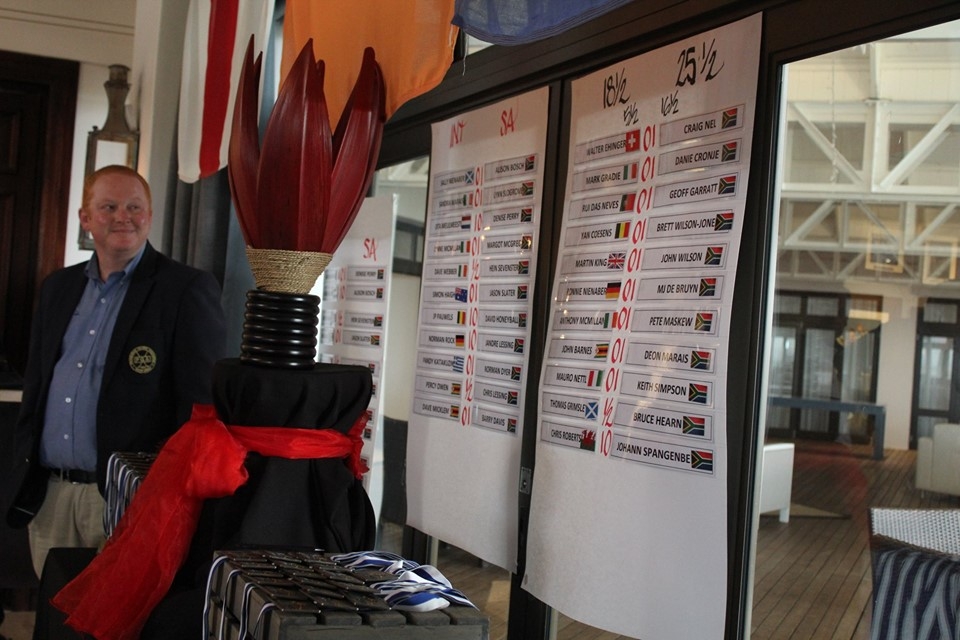 | SA took the next 9 1/2 games out of 11 played - OUCH! Final score - South Africa 25 1/2 and The Internationals 18 1/2 |
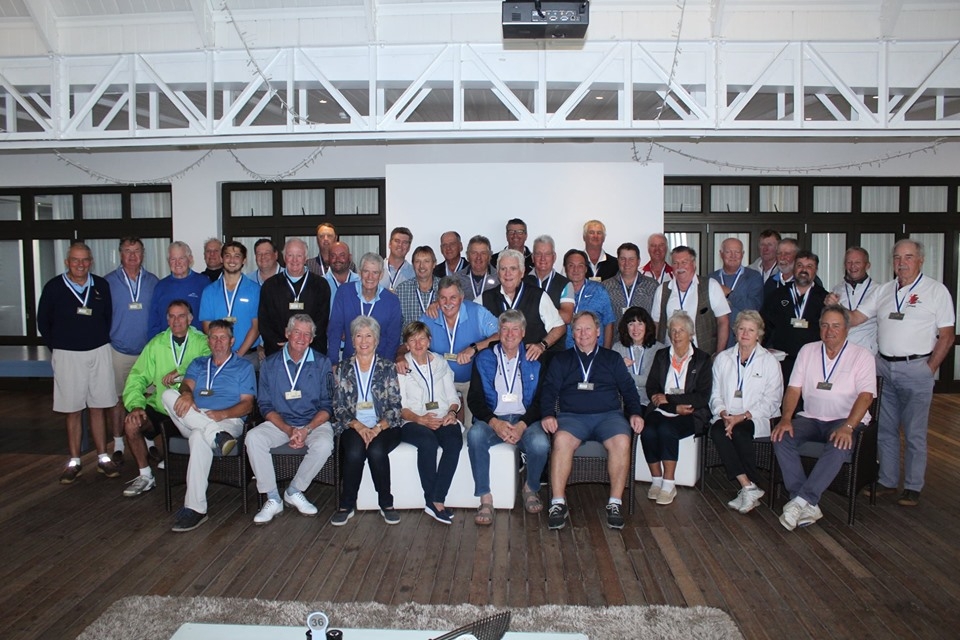 | | Even the Belgian, Yan Coesens, stood with the Saffers in the groups shot (4th from the back-left) hoping that next year he could play for them! |
In the comeback, Percy Owen trailed by 6 holes with 6 to play and tied the match. Dr Danie birdied the 1st and never looked back with a score in the 70's (matchplay). MJ De Bruyn rattled off 5 birdies in a row (12-16) coming from 4 down to beat Ronnie Nienaber. Jason Slater was one of the bright lights for the INT's when he shot 78 off 12 in winning. There were plenty of stories and plenty of laughs on and off the course.
The Links Cup is a great Club event and it continues to grow in numbers and spirit. Everyone wins when the great game of golf is played with great spirit. Special thanks to our captains, Dave Webber for the Internationals and Norman Pretorius for the South Africans!
Solheim Cup 2019
SUP Charl gained valuable experience at the Solheim Cup and shared some very special moments, too!
What an honour to have been part of the 2019 Solheim cup held at Gleneagles. We were a total of 50 volunteers from 11 different countries to work at this tournament. Everyone started as strangers and left as friends at the end of the tournament. Many stories and new ideas shared among all the course managers that were involved during tournament week.
The things learnt during this tournament were an eye-opener and I would like to share my experience with you today.
Our working day
Our schedule consisted of the following working hours:
04:00 – my alarm would go off
04:45 – Coffee and morning briefing
05:00 – get to your station leader and move down to the course together
05:30 to 09:00 – morning prep
10:00 to 15:00 – Any tasks /projects given to you on the day and then lunch at 15:00
16:00 to about 20:00 – evening prep.
During the 3 tournament days, we got time to rest after morning prep and you could either go and watch some golf or match rake for the tournament. I chose to match rake on the last day of the tournament during the singles games. I moved with the players inside the ropes and saw every shot played in front of my eyes. At 15:00 we would all gather and then start on the first hole with the evening prep of the course.
Green speed
Europe set up the golf course to suit their players the best. For the first two days, they asked for speeds of 9’5’’. This is where the art of consistent green-speed comes in and how to achieve it. We started each morning by doing a stimp reading before the first cut, and usually, the speed that was measured came in on about one foot short of the desired speed. A single cut usually did the trick to add a foot to the speed. If a green would have measured close to the desired speed, a single roll without cutting would have been an option.
Rain, wind and sun was always part of the consideration when preparing the greens because what happens later in the morning with regards to weather will have a huge effect on the speed of the greens during the tournament.
On the last day, the ladies wanted speed of 10’5’’ and the process was always the same to achieve a consistent speed. To achieve a higher speed, a green was given a single cut and stimped again, if the speed was still too slow a single roll was given after the cut and stimped again, and possibly cut again until the speed was consistent with the rest of the course. Only when the all-clear was given, everyone would move to the next green and start the process over. All the greens were within 2-3 inches from one another with regards to speed. This process was the same in the morning and in the afternoon after play.
During the tournament I was involved with stimping greens, taking moisture readings with a tool called a POGO, fixing divots, pitch marks repairs, masking of stressed areas on greens, plugging of bunker faces, raking of bunkers (Aussie bunker method). We got to do anything and everything to make this tournament a huge success.
I think I would highlight the work that I was involved with: taking moisture readings every morning and every afternoon. We did a minimum of 16 readings per green and at the end of the tournament, we had data that told a very interesting story. We could see the effect that high moisture had on the speed of the greens, what effect the SubAir System (a system that can suck moisture out of the soil and also has the feature of blowing fresh air into the soil profile from beneath the green profile) had under the greens, what effect the softer greens had on true height of cut and many other things.
The results were amazing to see with the ever-changing weather in Scotland. A softer green took a cutting height on greens from a set height of 3mm to a true height of cut on the greens to 2mm or 2,5mm depending on the moisture reading on the green. These are results that I have never seen before, and the effects it has on the plant is huge but can’t be seen by the naked eye. A lower cut means extra stress on the plant and possibly will result in a weaker plant. We used a prism tool to measure the true height of cut on the greens, and these results weren’t made public, all we were allowed to say was that the speed of the greens was tournament speed and the same was said about the height of cut.
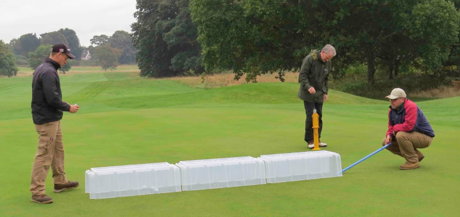 | | In windy conditions, the stimp reading gets done inside a portable tunnel for accurate results | Below you can see the POGO used for the moisture readings and the prism that was used for measuring the true height of cut.
Equipment
John Deere is the brand of turf equipment used at Gleneagles and we had enough equipment to do all we had to do for an unbelievable looking golf course. During the tournament, we maintained all three golf courses as normal, while also preparing the Kings course to tournament standards with the Junior Solheim Cup that was played there earlier in the week.
I took a lot of pictures of the workshop and got some ideas of how we can do things a bit better back home, but we are not far behind if behind at all.
Some fairways were too wet to cut with the ride-on fairway unit, and these fairways were cut by volunteers with walk-behind greens mowers every afternoon, this should give you an idea of the measures taken to ensure the perfect tournament.
St Andrews
Before going to Scotland, Keith Simpson put me in contact with the course manager of the Old course. I arranged to spend time with Gordon McKie and his team and helped set up the golf course one morning during the R&A member’s Tournament. We spoke the same turf language and I had such a good time with Gordon. After the morning prep, he showed me their workshops and the latest technology with regards to spraying equipment that works with accurate GPS tracking.
This rig switches the nozzles on and off depending on the area you are spraying, whether it is greens, tees or fairways. The operator only drives the machine over the areas and the rest is done automatically. They save so much on time and products being sprayed due to this system. Sad to say that this is not available in our country because of the specific satellites being used for the system.
St Andrews lease all their machines and they are on a 3-year turnaround for all their machines. When I told Gordon that we have to extend the lifetime of our machines to 6-8 years these days to be able to justify the purchase, he just smiled. I don’t think they know what it takes to make a machine last as long as we do in South Africa... hats off to my workshop crew!
Bunkers at the Solheim
The decision was made to rake the bunkers according to the Aussie method. This was something I have never heard about. This was only done for the tournament seeing that there were enough hands to pull this off. The bunkers would be smoothed off with the back of a normal rake, the bunker was smoothed with a squeegee roller and then a special rake was used to rake the base of the bunker as seen in the picture below.
Every afternoon the bunkers would be smoothed, and squeegees used to smooth it out again, and the next morning this process would be repeated. This method ensured that the ball would roll down into the bunker and end up on the flatter section of the bunker. The effect was great, and the bunkers were a proper feature of the tournament.
The Aussie Method
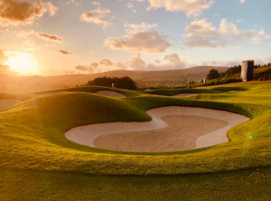 | 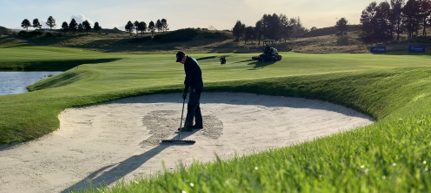 | | The bunker is levelled using the back of the rake and then rolled with a squeegee |
Finally, you rake the base of the bunker
Gleneagles and Old course staffing
What I have experienced was that the courses had less staff than us per course, but that they would move staff around the 3 courses as needed. Both Gleneagles and St Andrews have head counts of around 44 staff in total. They also make use of season workers that travel from course to course for a fixed term. I do believe that their labour cost will be more than ours, seeing that they are paying for the quality they get.
In Europe, they get along with less staff due to their competency. On both courses, the competency of all the staff is what caught my eye immediately along with the passion that they do their tasks with. It goes without saying that we would be able to do more with less staff if we had the structures in place for better education in South Africa and also if we had the freedom to appoint whoever we wanted, not based on any political agenda. I think we have a great team in place, and we will keep moving forward to become as good as we can be. When it comes to course conditioning and overall presentation of the golf course, we do not lack effort compared to other courses. I saw again that each course around the world has its own challenges with regards to weather, machinery, turf disease, and more. Much similar than to us.
New products and techniques
I stood in awe of what is available to the golf maintenance industry in Europe. Turf products that I have never seen before in SA and products that we buy in 5L containers are available in bulk 1000L containers. Quality green coloured sand we use for divots gets supplied in bulk, compost divot-mix for fairways in bulk, wash bays for cleaning the machines after cutting works on recycled water. There were so many things that make maintenance easier in Europe.
I have seen different ways of cutting fairways and greens, new bunker raking techniques that I might try for big tournaments on our course. I have already implemented a simple but necessary tool called a whipping pole to take of any access grass clippings from the greens after cutting. This is a simple example, but it does make a difference to presentation. When we tested green speed, we were told that they wanted 10’5’’ with a 110 slope. This was the first time I ever got to see a tool called a “Glegg” in action, this tool measures the firmness of the green and they wanted the firmness consistent with the speed of the green. We never got to have all the greens to an even firmness because of all the rain, but I did get to see the Glegg in action and another learning curve for me.
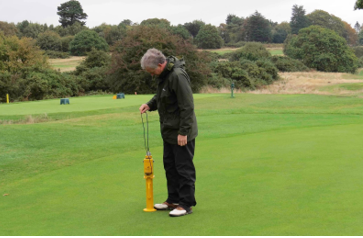 |
Walk-behind mowers compared to Tri-plex ride-on machines for greens
I made a point of it to ask both Craig Haldane (Gleneagles) and Gordon McKie (St Andrews) their opinions and their views when it comes to the quality of cut and ease of maintenance for cutting greens with the two choices.
Both said without a doubt that they prefer the tri-plex ride-on machines. There is no difference in the quality of cut and the advantages of the tri-plex outweighs the walk-behinds. The walkers give a better-looking presentation for tournaments, but for day to day maintenance, the Tri-plex wins. My head was also standing more towards a ride-on machine for our greens and I am now convinced.
In closing
The experience of the Solheim cup was truly and honour and I see it as a huge privilege to have played a part in this tournament.
I thank you all for giving me the opportunity to show the world what we have to offer in South Africa. St Francis Links was well presented in all my conversations and I can say with pride that I was a true ambassador for our course between all the different countries that helped during the Solheim Cup.
Yours in golf,
Charl Blaauw
The St Francis Links Hotel by Mantis
Show units are under construction
The proposed St Francis Links Hotel by Mantis is being sold as a sectional title scheme. Now, three units are being built as show units to promote sales.
The show unit, comprised of 1 two-bedroom unit and 2, one-bedroom units will be complete for the season. The Hotel will consist of 60 one and two-bedroom suites, modelled after the successful hotel development at Pearl Valley, where the 2nd phase was launched recently. The Clubhouse will be home to reception manned 24/7, the Food and Beverage services, AquaSpa and of course, the home of the Jack Nicklaus Signature Course! Pam Golding Properties are handling the sales for the Hotel. Neil Fox is the lead person. Email Neil Fox on neil.fox@pamgolding.co.za. Saria Blaauw is assisting and they are dividing their time at The Links.
Events to take part in
Selective Lighting Friday Competition | | | |  | | 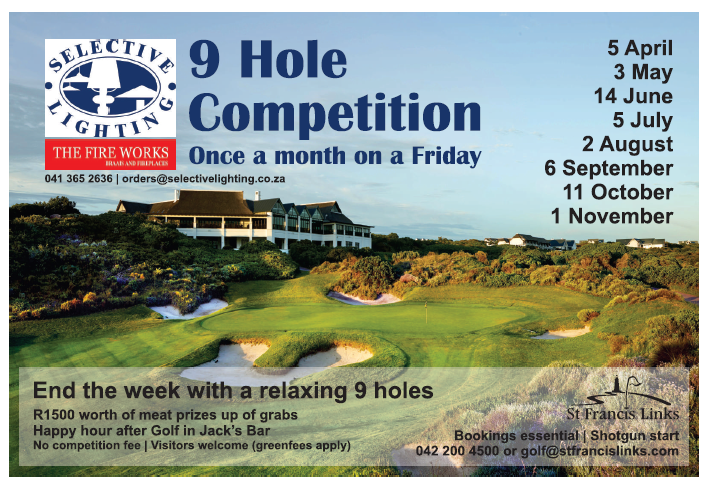 | | | | | Ernie and Linda Müller and their Team from Selective Lighting are making Fridays extra special at St Francis Links. Once a month, they host the Selective Lighting/The Fireworks Friday Competition. We shotgun start the players for 9 holes. Starting times are based on the season, 14:30 in the cooler season and 15:30 in the summer months. Be a part of growing the Club and join us for nine and some good times after golf! Please enter in advance for numbers.
Open Wednesdays
ITEC are our sponsors for Open Wednesday (2nd Wednesday) with meat and added prizes. Invite your friends to enjoy SA’s best with special rates for golf, snacks after the game and great prizes – Hey, sometimes Curry Night follows – stay or take away!
Monday Roll-up!
Pitch up and play (9 holes or 18 Par-3 from 2pm). Let's add you to the Whatsapp group.
All Day Saturdays
Morning and afternoon fields - the afternoon field will be booked from 12 noon backwards with emphasis on ready golf.
Monday Men's Book Club
5pm in Jack's Bar (no reading required).
Ladies' Tea (and coffee)
Every Tuesday at 10am on the Veranda.
Major events and winners 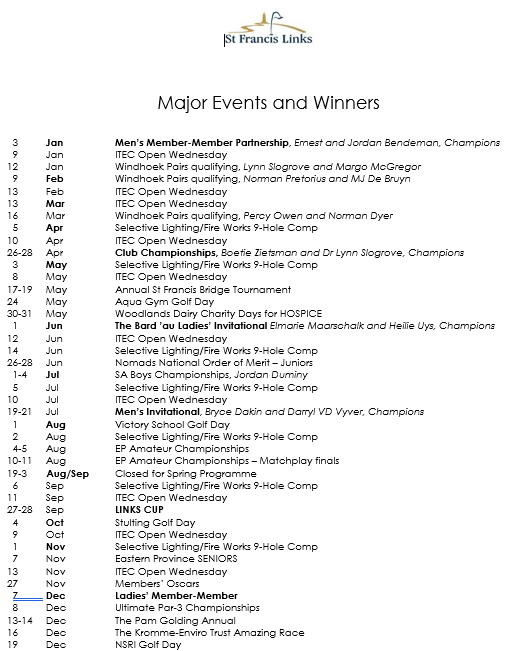 | | Click to enlarge | | | Thursday Competition 26 September 2019Fourball Alliance two scores to count1st Derek Tuchten, Frans Te Groen, Martin Te Groen and Francois Jordaan 96 ptsClick here for the full results. |